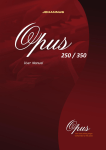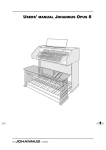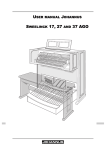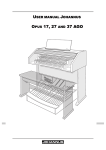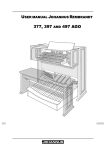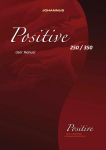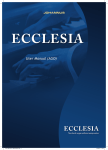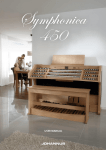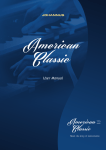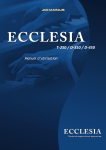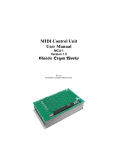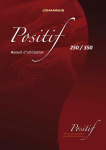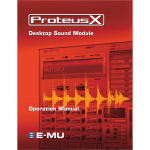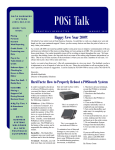Download T-250 / D-350 / D-450
Transcript
T-250 / D-350 / D-450 Manufacturer Johannus Orgelbouw b.v. Address Keplerlaan 2 6716 BS EDE Country The Netherlands Telephone +31 (0)318 63 74 03 Fax +31 (0)318 62 22 38 E-mail [email protected] Website www.johannus.com Version 1.0 Date May 2012 © 2012 Johannus Orgelbouw b.v. All rights reserved. Nothing in this publication may be reproduced, stored in a data file or made public in any form or in any way either electronically, mechanically by way of photocopying, recording or in any other way without the prior written permission of Johannus Orgelbouw b.v. User Manual Ecclesia T-250 / D-350 / D-450 2 CONTENTS 1 SAFETY........................................................................................... 5 1.1 1.2 1.3 1.4 2 Safety instructions ...................................................................................... 5 Symbols on the organ ................................................................................. 5 Symbols in this manual ............................................................................... 5 Transport and storage ................................................................................ 5 INSTALLATION ............................................................................... 6 2.1 Installation and connection ........................................................................ 6 2.1.1 2.1.2 2.1.3 2.2 2.3 2.4 3 Ecclesia T-250 ............................................................................................... 6 Ecclesia D-350............................................................................................... 7 Ecclesia D-450............................................................................................... 8 Opening and closing roll cover ................................................................... 9 Adjustable music desk (Ecclesia D-350) ...................................................... 9 Switch on .................................................................................................... 9 DESCRIPTION OF THE ORGAN ........................................................10 3.1 Overview of the components ................................................................... 10 3.1.1 3.1.2 3.1.3 3.2 Overview of controls................................................................................. 13 3.2.1 3.2.2 3.2.3 3.3 3.4 4 Ecclesia T-250 ............................................................................................. 10 Ecclesia D-350............................................................................................. 11 Ecclesia D-450............................................................................................. 12 Ecclesia T-250 ............................................................................................. 13 Ecclesia D-350............................................................................................. 14 Ecclesia D-450............................................................................................. 15 Connect and switch on the peripherals .................................................... 16 External connections ................................................................................ 16 OPERATION ..................................................................................17 4.1 4.2 4.3 4.4 4.5 4.6 4.7 4.8 General volume ........................................................................................ 17 Expression pedals ..................................................................................... 17 Cathedral .................................................................................................. 17 Intonations................................................................................................ 17 Stops ......................................................................................................... 17 Couplers .................................................................................................... 18 Accessories ............................................................................................... 19 Capture memory ....................................................................................... 19 4.8.1 4.8.2 4.8.3 Pre-programmed memory locations .......................................................... 19 Capture memory locations ......................................................................... 20 Memory lock .............................................................................................. 21 4.9 Transposer ................................................................................................ 21 4.10 Crescendo Pedal ....................................................................................... 21 4.11 Quick Access ............................................................................................. 21 4.11.1 4.11.2 4.11.3 5 Programming mode Crescendo Pedal ........................................................ 22 Adjusting Tremulant Vox Humana (Ecclesia D-450) ................................... 22 Keyboard assignment Orchestrals .............................................................. 22 JOHANNUS MENU .........................................................................23 5.1 5.2 5.3 5.4 5.5 5.6 5.7 5.8 Crescendo ................................................................................................. 23 Datadump ................................................................................................. 23 Expression Pedals ..................................................................................... 24 General Volume ........................................................................................ 25 Keyboard Config ....................................................................................... 25 Key Volumes ............................................................................................. 26 MIDI Config ............................................................................................... 28 Orchestrals ................................................................................................ 28 User Manual Ecclesia T-250 / D-350 / D-450 3 5.9 5.10 5.11 5.12 5.13 5.14 5.15 6 Reset Procedures ...................................................................................... 29 Reverb Settings ......................................................................................... 30 Startup Settings ........................................................................................ 30 Temperaments.......................................................................................... 32 Tremulant Vox Humana (Ecclesia D-450) ................................................. 33 Tuning ....................................................................................................... 33 Version ...................................................................................................... 34 OPTIONAL VOICE PACKAGES .........................................................35 6.1 6.2 7 Characteristics per voice........................................................................... 35 Exclusions.................................................................................................. 41 MAINTENANCE, TROUBLESHOOTING AND WARRANTY..................42 7.1 Maintenance ............................................................................................. 42 7.1.1 7.1.2 7.2 7.3 8 Maintenance of the cabinet ....................................................................... 42 Maintenance of the manuals ..................................................................... 42 Problems ................................................................................................... 42 Warranty ................................................................................................... 42 MIDI IMPLEMENTATIONS ..............................................................43 8.1 8.2 MIDI Implementation Chart...................................................................... 43 MIDI Specifications ................................................................................... 44 User Manual Ecclesia T-250 / D-350 / D-450 4 1 SAFETY 1.1 Safety instructions 1.2 Position the organ on a stable, horizontal surface. Connect the organ to a grounded power socket. Turn off the organ when it is not in use. Do not place the organ in a damp area. Do not expose the organ to liquids. Follow the instructions and precautionary measures in this user manual. Keep this user manual with the organ. The organ may only be opened by a technician authorized by Johannus Orgelbouw b.v. The organ contains static-sensitive components. The warranty is void if the organ is opened by a non-authorized person. Symbols on the organ Warning Warning for electric shock Warning for static-sensitive components 1.3 Symbols in this manual Warning or important information Note 1.4 Transport and storage Pay attention to the following during transport and storage: 1. Remove the music desk and the pedal board from the organ. 2. Relative humidity within the storage area: 40 to 60%. User Manual Ecclesia T-250 / D-350 / D-450 5 2 INSTALLATION 2.1 Installation and connection 2.1.1 Ecclesia T-250 A B C D Installing loudspeakers: The external loudspeakers have to be installed by an authorized Johannus installer. Installing console: 1. Position the organ on a stable, horizontal surface. 2. Lean the organ slightly backward. 3. Slide the pedal board (D) against the organ. 4. Set the organ upright. 5. Put the music desk (A) in the groove on the cover of the organ. 6. Place the organ bench (C) over het pedal board. 7. Make sure the voltage of the organ matches the voltage of the main. See the serial plate (B). 8. Connect the organ to a grounded power socket. User Manual Ecclesia T-250 / D-350 / D-450 6 2.1.2 Ecclesia D-350 A B C D Installing loudspeakers: The external loudspeakers have to be installed by an authorized Johannus installer. Installing console: 1. Position the organ on a stable, horizontal surface. 2. Lean the organ slightly backward. 3. Slide the pedal board (D) against the organ. 4. Set the organ upright. 5. Install the music desk (A) by sliding the music desk support in the support sliders on top of the organ. 6. Place the organ bench (C) over het pedal board. 7. Make sure the voltage of the organ matches the voltage of the main. See the serial plate (B). 8. Connect the organ to a grounded power socket. User Manual Ecclesia T-250 / D-350 / D-450 7 2.1.3 Ecclesia D-450 A B C D Installing loudspeakers: The external loudspeakers have to be installed by an authorized Johannus installer. Installing console: 1. Position the organ on a stable, horizontal surface. 2. Lean the organ slightly backward. 3. Slide the pedal board (D) against the organ. 4. Set the organ upright. 5. Put the music desk (A) in the appropriate slots. These slots are in the outside of the cabinets with draw stops. 6. Place the organ bench (C) over het pedal board. 7. Make sure the voltage of the organ matches the voltage of the main. See the serial plate (B). 8. Connect the organ to a grounded power socket. User Manual Ecclesia T-250 / D-350 / D-450 8 2.2 Opening and closing roll cover The organ can be closed with a wooden roll cover that has a lock. The roll cover lock is positioned behind the music desk. Opening - Put the key in the roll cover lock. - Turn the key a quarter turn to the left. The lock now comes out. - Slide the roll cover upwards. Never leave the key in the area that can be closed! It is recommended to leave the key in the lock. Closing - Slide the roll cover downwards. - Press the roll cover lock in. - Turn the key a quarter turn to the right. 2.3 Adjustable music desk (Ecclesia D-350) The music desk is adjustable in depth and in height. Do not adjust the music desk with music books on it. To adjust the depth, grasp the music desk on both sides and pull it towards you or push it away from you. Do not pull the music desk too far towards you so that the music desk supports are drawn out of the support slides. To adjust the height, squeeze the clamps behind the music desk on both sides and shift the height. 2.4 Switch on Switch on the organ with the on/off piston at the right, next to the manuals. Wait several seconds. Starting the control functions and the settings will take some time. The lights of the 0 piston and the as standard set functions lit up. The settings appear on the display. User Manual Ecclesia T-250 / D-350 / D-450 9 3 DESCRIPTION OF THE ORGAN 3.1 Overview of the components 3.1.1 Ecclesia T-250 A B C D E F G A Roll cover lock (behind music desk) B Music desk C Roll cover D Organ bench E Swell pedal F Crescendo pedal G Pedal board User Manual Ecclesia T-250 / D-350 / D-450 10 3.1.2 Ecclesia D-350 A B C D E F G A Roll cover lock (behind music desk) B Adjustable music desk C Roll cover D Organ bench E Swell pedal F Crescendo pedal G Pedal board User Manual Ecclesia T-250 / D-350 / D-450 11 3.1.3 Ecclesia D-450 A B C D E F G A Roll cover lock (behind music desk) B Roll cover C Folding music desk D Organ bench E Swell pedal F Crescendo pedal G Pedal board User Manual Ecclesia T-250 / D-350 / D-450 12 3.2 Overview of controls 3.2.1 A B C D E F G H I J K L M N Ecclesia T-250 Pedal stops Great stops Display Roll cover lock Swell stops Memory lock SET / ENTER KT: Keyboard Transfer Capture memory locations Pre-programmed memory locations 0: Recall / Reset RO: Reeds Off CH: Chorus MB: Manual Bass User Manual Ecclesia T-250 / D-350 / D-450 O P Q R S T U V W X Y Z AA AB CF: Cantus Firmus TRANS.: Transposer - and + pistons CR: Crescendo MENU Manual Great Manual Swell On/Off SEQ- and SEQ+ pistons S/S: All Swells to Swell MIDI stops Intonation styles Orchestral solo voices Orchestral voices 13 3.2.2 A B C D E F G H I J K L M N O Ecclesia D-350 Pedal stops Great stops Display Roll cover lock Swell stops Choir stops Memory lock SET / ENTER KT: Keyboard Transfer Capture memory locations Pre-programmed memory locations 0: Recall / Reset RO: Reeds Off CH: Chorus MB: Manual Bass User Manual Ecclesia T-250 / D-350 / D-450 P Q R S T U V W X Y Z AA AB AC AD CF: Cantus Firmus TRANS.: Transposer - and + pistons CR: Crescendo MENU Manual Choir Manual Great Manual Swell On/Off SEQ- and SEQ+ pistons S/S: All Swells to Swell MIDI stops Intonation styles Orchestral solo voices Orchestral voices 14 3.2.3 A B C D E F G H I J K L M N O Ecclesia D-450 Pedal stops Great stops Display Roll cover lock Swell stops Choir stops Memory lock SET / ENTER KT: Keyboard Transfer Capture memory locations Pre-programmed memory locations 0: Recall / Reset RO: Reeds Off CH: Chorus MB: Manual Bass User Manual Ecclesia T-250 / D-350 / D-450 P Q R S T U V W X Y Z AA AB AC AD CF: Cantus Firmus TRANS.: Transposer - and + pistons CR: Crescendo MENU Manual Choir Manual Great Manual Swell On/Off SEQ- and SEQ+ pistons S/S: All Swells to Swell MIDI stops Intonation styles Orchestral solo voices Orchestral voices 15 3.3 Connect and switch on the peripherals You can connect peripherals (for example, a MIDI device) to the organ. Follow the instructions provided in the documentation for the peripheral. 1. 2. 3. 4. 3.4 Switch off the organ and the peripheral. Connect the peripheral to the organ. Switch on the peripheral. Switch on the organ. External connections The external connections are on the left under the console. MIDI IN: An input for receiving MIDI codes from other devices. MIDI MOD: A programmable MIDI output for connecting a sound module or expander, for example. MIDI SEQ: A non-programmable MIDI output for connecting a sequencer or PC (with the optional Johannus Intonat program), for example. AUX IN: A stereo audio input for playing the sound of an external device through the amplifiers of the organ. For example, an expander connected to the organ through the MIDI MOD can be played through the instrument's loudspeakers. AUX OUT: A stereo audio output for connecting an external device (amplifier or recording device, for example). PHONES: This connection for a (stereo) headphone is suited for a headphone with an impedance of 30 Ω or more (see headphone specifications). When the headphone is used, the loudspeakers of the organ are switched off automatically. User Manual Ecclesia T-250 / D-350 / D-450 16 4 OPERATION 4.1 General volume The general volume of the organ can be adjusted with use of the Johannus Menu. See § 5.4 General Volume. 4.2 Expression pedals In the standard version the organ has two expression pedals. One is configured as a swell pedal for the Swell, and one is configured as a crescendo pedal. With use of the Johannus Menu, the function of the expression pedals can be changed, see § 5.3 Expression Pedals. Using an expression pedal which is set as a swell pedal will next to the volume also changes the timbre of the stops. By this the effect of the swell box shutters of a pipe organ is simulated. Extra expression pedal (optional) If the organ has the optional Luxury Package an extra expression pedal is available. This expression pedal standard is configured as swell pedal for the Great and Pedal (Ecclesia T-250) or Choir, Great and Pedal (Ecclesia D-350/D-450). This function can be changed using the Johannus Menu, see § 5.3 Expression Pedals. 4.3 Cathedral The organ is equipped with the Adaptive Surround Reverb ASR-12 system. This effect provides a spatial reproduction of the organ sound. With use of the Johannus Menu the following settings are to adjust per intonation style: Reverb Program, Reverb Length, Reverb Volume and 3D Surround effect. See § 5.10 Reverb Settings. 4.4 Intonations The organ has 4 intonations: Romantic (ROM), Symphonic (SYM), Baroque (BAR) and Historic (HIS). Select an intonation style by pressing the ROM, SYM, BAR or HIS piston. 4.5 Stops The stops are activated via stop switches, pre-programmed memory locations or capture memory locations. The lamp of the stop switch lights when the associated stop is active. The stops are divided into the following groups: Pedal: Activates the stops associated with the Pedal. Choir: Activates the stops associated with the Choir (Ecclesia D-350/D-450). User Manual Ecclesia T-250 / D-350 / D-450 17 Great: Swell: Activates the stops associated with the Great. Activates the stops associated with the Swell. Solo- and orchestral voices (optional) If the organ is equipped with the optional Premium or Platinum Voice Package a number of solo- and orchestral voices are available. These solo- and orchestral voices are activated by thumb pistons on the piston rail between the manuals. The lamp in the thumb piston lights when the associated voice is active. See chapter 6 OPTIONAL VOICE PACKAGES for more information on solo- and orchestral voices. Solo- and orchestral voices are standard playable from a factory defined manual. This can be changed via Quick Access, see § 4.11.3 Keyboard assignment Orchestrals, and via the Johannus Menu, see § 5.8 Orchestrals. 4.6 Couplers Manual couplers: CHOIR - GREAT (Ecclesia D-350/D-450): Fully couples all keys of the Choir to the Great. SWELL - GREAT: Fully couples all keys of the Swell to the Great. SWELL - CHOIR (Ecclesia D-350/D-450): Fully couples all keys of the Swell to the Choir. Pedal couplers: CHOIR - PEDAL (Ecclesia D-350/D-450): Fully couples all keys of the Choir to the Pedal. GREAT - PEDAL: Fully couples all keys of the Great to the Pedal. SWELL - PEDAL: Fully couples all keys of the Swell to the Pedal. Manual Bass (MB): Couples the Pedal monophonic to the Great. Only the lowest key that is played on the Great is coupled from the Pedal to the Great. If only the lowest key of a chord is released, the pedal key activated by the Manual Bass function is dropped until a new lowest key is played. Activate the Manual Bass with the MB piston. It is advisable not to use the Manual Bass while playing the pedal board to avoid double bass tones. Cantus Firmus (CF): Cantus firmus: Latin for ‘fixed voice’ or in organs ‘solo voice’ or ‘melody coupler’. Couples the Swell monophonic to the Great. Only the highest key that is played on the Great is coupled from the Swell to the Great. User Manual Ecclesia T-250 / D-350 / D-450 18 With use of a solo registration on the Swell in this way a solo is heard while playing only on the Great. If only the highest key of a chord is released, the key activated by the Cantus Firmus function is dropped until a new highest key is played. Activate the Cantus Firmus with the CF piston. It is advisable not to use the Cantus Firmus in combination with the coupler SWELL - GREAT because this overrules the solo function of the Cantus Firmus. 4.7 Accessories Keyboard Transfer (KT): Ecclesia T-250: Keyboard Transfer is a function to switch the manuals of the Great and the Swell. When Keyboard Transfer is active manual 1 is the Swell manual and manual 2 is the Great manual. Ecclesia D-350/D-450: Keyboard Transfer is a function to switch the manuals of the Choir and the Great. When Keyboard Transfer is active manual 1 is the Great manual and manual 2 is the Choir manual. Activate the Keyboard Transfer with the KT piston. Chorus (CH): Chorus is a function for lightly detuning the organ stops to give it a broader and livelier sound. Activate the Chorus with the CH piston. Reeds Off (RO): Reeds Off is a function to switch off all reed stops simultaneously. As long as this piston is pressed, no reed stops can be activated. When this function is switched off, the reed stops that were on are activated again. Activate the Reeds Off with the RO piston. Recall / Reset function (0): The 0 piston cancels stops in two ways: 1. A short press on the 0 piston: Only the last change is cancelled. 2. A long press on the 0 piston: All stops are cancelled. Sequence - and + Sequence is a function for sequential selecting capture memory locations. 1. Select a capture memory location to start (for example level 2, location 2). 2. Use the SEQ- or SEQ+ pistons to select the previous or next capture memory location. 4.8 Capture memory 4.8.1 Pre-programmed memory locations Pre-programmed memory locations are available by operating pistons PP to T. These six memory locations have factory settings (presets) appropriate for the quiet pianissimo to the loud tutti. User Manual Ecclesia T-250 / D-350 / D-450 19 Calling up a pre-programmed memory location: Press a pre-programmed memory location (PP-T). The active stops light up. Programming a pre-programmed memory location: The current setting of the pre-programmed memory location will be lost. Although it is possible to store any registration under a piston of a preprogrammed memory location it is advisable to select a registration matching the text of the piston. 1. 2. 3. 4. Select the desired stops. Press the SET piston. Hold in the piston. Press the desired pre-programmed memory location (PP-T). Release the SET piston. 4.8.2 Capture memory locations Through use of the capture memory, a registration can be activated with just one piston. The capture memory consists of 250 levels. These levels can be seen on the display (Mem:…). Each level has eight memory locations (pistons 1-8). The 2000 capture memory locations are not preprogrammed and can be programmed by the musician. Programming a capture memory location: The current setting of the capture memory location will be lost. 1. 2. 3. 4. 5. Select the desired stops. Use the - and + pistons to select a level (1-250) on the display. Press the SET piston. Hold in the piston. Press the desired memory location (1-8). Release the SET piston. Calling up a capture memory location: 1. Use the - and + pistons to select the desired level (1-250) on the display. 2. Press the desired memory location (1-8). The active stops light up. Through use of the SEQ- and SEQ+ pistons previous or next memory locations can be selected in steps of one. The lighted memory location piston and the memory level shown in the display indicate the selected location. User Manual Ecclesia T-250 / D-350 / D-450 20 4.8.3 Memory lock The memory can be secured through a key switch. By turning the key a quarter to the right, the security of the memory is removed. In this position, the key can not be taken out of the lock. Turn the key a quarter to the left to avoid unwanted overwriting of the memory. Optionally the key can be taken out of the lock. The actual state of the memory lock is also reflected in the SET piston. This piston will light when the key of the memory lock is turned to the right, indicating that the SET piston can be used. If the SET piston is not lighted, no menu functions for which the SET piston needs to be pressed can be used. 4.9 Transposer The Transposer function shifts the pitch by half-tone increments (from -8 to +8). The transposer setting can be read on the display (Trans: …). 1. 2. 3. Press the TRANS piston. Use the - and + pistons to set the pitch. When the transposer change needs to be saved, press the SET piston in the time the TRANS. piston is lit. 4.10 Crescendo Pedal The crescendo pedal can be used to activate 20 registrations step-by-step. These registrations start with very quiet (pianissimo) to very loud (tutti). The default registrations of the 20 steps can be changed. See § 5.1 Crescendo. Activating the crescendo pedal If the crescendo pedal is not activated it is indicated on the displays with Cresc:Off. Use the CR piston to activate the crescendo pedal. The display indicates the actual step. Crescendo pedal as additional swell pedal The crescendo pedal can also be configured as a swell pedal. See § 5.3 Expression Pedals. If the crescendo pedal is set as additional swell pedal, all functions of the original crescendo pedal are deactivated. 4.11 Quick Access Quick Access is a function to quickly access certain function of the organ. User Manual Ecclesia T-250 / D-350 / D-450 21 4.11.1 Programming mode Crescendo Pedal This function is not available if no expression pedal is set as crescendo pedal. Pressing the SET and CR piston simultaneously enters the programming mode of the crescendo pedal. See § 5.1 Crescendo, sub 4 for next steps. 4.11.2 Adjusting Tremulant Vox Humana (Ecclesia D-450) Hold the SET-piston and switch on Tremulant Vox Humana. The settings of the Tremulant Vox Humana appear on the display. See § 5.13 Tremulant Vox Humana for further steps. 4.11.3 Keyboard assignment Orchestrals This function is only available if the organ is equipped with the optional Premium or Platinum Voice Package. Through use of Quick Access it is possible to assign a solo- or orchestral voice directly to a manual or the pedal. Press the SET piston simultaneously with a piston of a solo- or orchestral voice, for example Panflute. The actual assignment appears on the display. Press a key of the manual or the pedal on which the solo- or orchestral voice has to be assigned or press the SET- or MENU-piston to cancel. User Manual Ecclesia T-250 / D-350 / D-450 22 5 JOHANNUS MENU In the Johannus Menu several functions of the organ can be set. Press the MENU piston to activate the Johannus Menu on the display. Navigating the menu is done with the - and + pistons. Confirmation of a choice is done with the SET piston. Cancel or step back in the menu is done with the MENU piston. The Johannus Menu consists of the following functions: 5.1 Function More information Crescendo Datadump Expression Pedals General Volume Keyboard Config Key Volumes MIDI Config Orchestrals Reset Procedures Reverb Settings Startup Settings Temperaments Tremulant Vox Humana Tuning Version § 5.1 § 5.2 § 5.3 § 5.4 § 5.5 § 5.6 § 5.7 § 5.8 § 5.9 § 5.10 § 5.11 § 5.12 § 5.13 § 5.14 § 5.15 Crescendo The crescendo pedal contains 20 pre-programmed registrations. These registrations start with very quiet (pianissimo) to very loud (tutti). These pre-programmed registrations can be changed. Step 0 of the crescendo pedal cannot be changed. 1. 2. 3. 4. 5. 6. 7. 5.2 Press the MENU-piston. Use the - and + pistons to select the Crescendo function on the display. Press the SET piston. The first step of the crescendo pedal appears on the display. Use the - and + pistons to select the step which has to be changed. Change the registration and press the SET piston to save the new registration in the memory of the organ. Repeat steps 5 and 4 if more crescendo pedal steps has to be changed. Press the MENU piston 2x to exit the Johannus Menu. Datadump The Datadump function sends several settings from the organ to a storage medium (the Johannus Sequencer+, for example) through the MIDI SEQ output. See § 3.4 External connections. User Manual Ecclesia T-250 / D-350 / D-450 23 The settings to sent are: the content of all capture memory locations and all settings which can be set via the Johannus Menu, except Key Volumes. Key Volume settings are a part of the intonation data. These data can be received with the optional Johannus Intonat software. a. Sending data from the organ 1. Press the MENU-piston. 2. Use the - and + pistons to select the Datadump function on the display. 3. Press the SET piston. The Press SET to send data text appears on the display. 4. Make sure the desired storage medium, the Johannus Sequencer+ for example, is properly connected. 5. Press the SET piston. When data is being sent, Sending data appears on the display. Sending data will take some time. Do not use the organ when the Sending data text is on the display. 6. 7. If the data dump is complete, the main menu appears on the display. Press the MENU piston to exit the Johannus Menu. b. Uploading data to the organ Receiving a data file has no relation to the Johannus Menu and can be done on every moment the organ is switched on, except when playing a Demo Song. Make sure to upload only data files which are recorded from the instrument concerned. Uploading a data file from another instrument may jeopardize the functioning of your instrument. 1. 2. 3. 5.3 Make sure the storage medium, the Johannus Sequencer+ for example, with a previous recorded data file is properly connected. Start sending the data file on the sequencer. A message that a data file is being received appears on the display of the organ. When the upload is completed the main screen of the display appears automatically. Expression Pedals The Rembrandt 350 is equipped with PEPC™ (Programmable Expression Pedal Configuration). This function makes it possible to configure each expression pedal to one’s own discretion. We distinguish two types of expression pedals: Swell pedal: dynamics by increase or decrease of volume. In a pipe organ this is achieved by closing or opening the swell shutters of a swell box. See also § 4.2 Expression pedal. Crescendo pedal: dynamics by increase or decrease the amount of stops. See also § 4.10 Crescendo Pedal. User Manual Ecclesia T-250 / D-350 / D-450 24 a. An expression pedal can be configured as a swell pedal for several divisions at the same time. b. A division can only be connected to one expression pedal at the same time. c. An expression pedal cannot be configured as a swell pedal and a crescendo pedal at the same time. 1. 2. Press the MENU piston. Use the - and + pistons to select the Expression Pedals function on the display. 3. Press the SET piston. The available expression pedals appear on the display. 4. Use the - and + pistons to select the expression pedal the function of which must be changed. 5. Press the SET piston. The available possibilities appear on the display. Behind the possibilities the actual setting is marked with a checkmark. 6. Use the - and + pistons to select the desired setting. Ch : Swell pedal for Choir (Ecclesia D-350/D-450) Gt/Pd : Swell pedal for Great and Pedal Sw : Swell pedal for Swell Cresc : Crescendo pedal 7. Press the SET piston. The pointer jumps to the choice position. 8. Use the - and + pistons to select the functionality. 9. Press the SET piston for confirmation. 10. Press the MENU piston to return to the Expression Pedals menu. 11. If necessary, repeat steps 4 to 10 for another expression pedal. 12. Press the MENU piston 2x to exit the Johannus Menu. 5.4 General Volume The General Volume function sets the general volume of the organ. 1. 2. 3. 4. 5. 6. 5.5 Press the MENU piston. Use the - and + pistons to select the General Volume function on the display. Press the SET piston. The actual setting appears on the display. Use the - and + pistons to select the desired volume. Press the SET piston to program the selected volume into memory and to return to the Johannus Menu. Press the MENU piston exit the Johannus Menu. Keyboard Config The Keyboard Config function sets the operation of the keys. 1. 2. 3. Press the MENU piston. Use the - and + pistons to select the Keyboard Config function on the display. Press the SET piston. The available manuals appear on the display. User Manual Ecclesia T-250 / D-350 / D-450 25 4. 5. 6. 7. 8. 5.6 Use the - and + pistons to select the manual the setting of which must be changed. Press the SET piston. The available options appear on the display. Use the - and + pistons to select a setting for the operation of the keys. - Automatic: The manual has been set to High. When activating a programmable MIDI stop or optional solo- or orchestral voice, the manual will be set to Velocity automatically. - High: The keys respond when touched very lightly. - Low: The keys respond when pressed further. - Velocity: The keys are touch-sensitive. Press the SET piston to program the settings. The available manuals appear on the display again. Repeat steps 4 to 7 to change the setting of another manual or press the MENU piston 2x to exit the Johannus Menu. Key Volumes The Key Volumes function makes it possible to adjust the key volumes of each stop. The Key Volumes function consists of the following sub functions: Adjust Reset one stop Reset ALL stops a. Adjust The Adjust function sets the volume per key, stop and intonation style. Key volumes of the optional solo- and orchestral voices cannot be adjusted. 1. 2. 3. 4. 5. Switch off all stops. Select an intonation style or variation. Press the MENU piston. Use the - and + pistons to select the Key Volumes function on the display. Press the SET piston. The sub functions of the Key Volumes menu appears on the display. If you are asked to enter a code, the Key Enter code: Volumes function has been secured at the _ _ _ _ request of the owner. Contact the owner or dealer to retrieve the code. Enter the code using the pistons of the capture memory locations and press the SET piston. Use the - and + pistons to select the sub function Adjust and press the SET piston. A question to select a stop to adjust appears on the display. 7. Activate one stop. A question to press a key appears on the display. 8. Press one key on the corresponding division and hold the key. The display will now show following Key: the key indicator and following Vol: the volume. 9. Use the - and + pistons to set the desired volume. 10. Press the SET piston to save the change. The display requests confirmation. Use the - and + pistons to select No or Yes. 11. Press the SET piston to confirm. 12. Press the MENU piston to return to the Key Volume menu. 6. User Manual Ecclesia T-250 / D-350 / D-450 26 13. If the changes have not been saved, the display will show Discard changes?. Use the - and + pistons to select Yes for discarding and press the SET piston. Go to step 17. 14. Use the - and + pistons to select No if the changes still has to be saved and press the SET piston. 15. Press the SET piston. The display requests confirmation. 16. Use the - and + pistons to select Yes. Press the SET piston for confirmation. 17. Press the MENU piston 3x to exit the Johannus Menu. More key volumes can be changed by pressing another key or by selecting another stop. b. Reset one stop The Reset one stop sub function resets the key volumes for one stop in one intonation or variation to the factory setting. 1. Switch off all stops. 2. Select an intonation style or variation. 3. Press the MENU piston. 4. Use the - and + pistons to select the Key Volumes function on the display. 5. Press the SET piston. The sub functions of the Key Volumes menu appear on the display. If you are asked to enter a code, the Key Enter code: Volumes function has been secured at the _ _ _ _ request of the owner. Contact the owner or dealer to retrieve the code. Enter the code using the pistons of the capture memory locations and press the SET piston. Use the - and + pistons to select the Reset one stop sub function on the display. 7. Press the SET piston. A question to select a stop to reset appears on the display. 8. Activate one stop. A question to confirm appears on the display. 9. Use the - and + pistons to select No or Yes. 10. Press the SET piston to confirm and to return to the Key Volumes menu. 11. Press the MENU pistons 2x to exit the Johannus Menu. 6. c. Reset ALL stops The Reset ALL stops function resets the key volumes of all stops in one intonation style or variation to the factory setting. 1. Select an intonation style or variation. 2. Press the MENU piston. 3. Use the - and + pistons to select the Key Volumes function on the display. 4. Press the SET piston. The sub functions of the Key Volumes menu appear on the display. If you are asked to enter a code, the Key Enter code: Volumes function has been secured at the _ _ _ _ request of the owner. Contact the owner or dealer to retrieve the code. Enter the code using the pistons of the capture memory locations and press the SET piston. User Manual Ecclesia T-250 / D-350 / D-450 27 5. 6. 7. 8. 9. 5.7 Use the - and + pistons to select the Reset ALL stops sub function on the display. Press the SET piston. A question to confirm appears on the display. Use the - and + pistons to select No or Yes. Press the SET piston to confirm and to return to the Key Volumes menu. Press the MENU piston 2x to exit the Johannus Menu. MIDI Config MIDI is a protocol for communication between the organ and other devices, such as PC, Johannus Sequencer+ or other musical instruments. The programmable MIDI stops allow you to control any module voice through any MIDI channel (1-16). The four parts of the programmable MIDI code are: Channel, Msb, Lsb en Voice. 1. 2. 3. 4. 5. 6. 7. 8. 9. 10. 11. 12. 13. 5.8 Press the MENU piston. Use the - and + pistons to select the MIDI Config function on the display. Press the SET function. A question to select a MIDI stop to configure appears on the display. Activate the MIDI stop which has to be configured. The settings of the corresponding MIDI stop appear on the display. An pointer is located in front of the value of the MIDI channel. Use the - and + pistons to select the desired MIDI channel. Press the SET piston. The pointer jumps to the MSB value. Use the - and + pistons to select the desired MSB value. Press the SET piston. The pointer jumps to the LSB value. Use the - and + pistons to select the desired LSB value. Press the SET piston. The pointer jumps to the Voice value. Use the - and + pistons to select the desired Voice value. Press the SET piston. The selected configuration is now stored in memory. The pointer jumps back to the MIDI channel location. Press the MENU piston 2x to exit the Johannus Menu. Orchestrals The Orchestral menu is only available if the organ is equipped with the optional Premium or Platinum Voice Package. With the optional Premium or Platinum Voice Package the organ is enlarged with a number of solo- and orchestral voices. Solo- and orchestral voices are standard playable from a factory defined manual. This can be changed via the Johannus Menu. Assigning a solo- or orchestral voice to a manual or pedal can also be done with the Quick Access function. See § 4.11 Quick Access. User Manual Ecclesia T-250 / D-350 / D-450 28 1. 2. 3. 4. 5. 6. 7. 5.9 Press the MENU piston. Use the - and + pistons to select the Orchestrals function on the display. Press the SET piston. The solo- and orchestral voices appear on the display. Use the - and + pistons to select the solo- or orchestral voice from which the assignment has to be changed. Press the SET piston. The actual assignment of the solo- or orchestral voice appears on the display. Press a key on the manual or pedal on which the solo- or orchestral voice has to be assigned. The new assignment appears on the display. Press the MENU piston 3x to exit the Johannus Menu. Reset Procedures The Reset Procedures function can be used to reset a number of settings to the factory settings. 1. 2. 3. 4. 5. 6. 7. Press the MENU piston. Use the - and + pistons to select the Reset Procedures function on the display. Press the SET piston. The available Reset Procedures appear on the display. Use the - and + pistons to select the desired reset procedure: - Crescendo def.: Resets the factory settings of the 20 steps of the crescendo pedal. - Cust. Temperament def.: Resets the custom programmable temperament to equal temperament. - Expression Pedals def.: Resets the factory settings of the expression pedals. - Memory default: Clears the entire capture memory. - MIDI default: Resets the factory settings of the MIDI stops. - Preset default: Resets the factory settings of the preprogrammed memory locations. - Reverb default: Resets the factory settings of the reverb. The following reset procedures are only available if the organ is equipped with the optional Premium or Platinum Voice Package: - Orchestrals default: Resets the factory setting of the solo- and orchestral voices. - Special Stop mode def.: Resets the factory settings of some special settings for some orchestral voices. Press the SET piston. A question to confirm appears on the display. Use the - and + pistons to select No or Yes. Press the SET piston to confirm and to return to the Reset Procedures menu. Press the MENU piston 2x to exit the Johannus Menu. User Manual Ecclesia T-250 / D-350 / D-450 29 5.10 Reverb Settings The organ is equipped with the Adaptive Surround Reverb ASR-12 system. With this system it is possible to choose a matching reverb for each intonation style. The volume and length of the reverb can be changed and a 3D Surround effect can be enabled. 1. 2. 3. 4. 5. 6. 7. 8. 9. Use the intonation style pistons to activate an intonation style the reverberation of which has to be changed. Press the MENU piston. Use the - and + pistons to select the Reverb Settings function on the display. Press the SET piston. A list of available sub functions appears on the display. Use the - and + pistons to select the desired sub function. Press the SET piston. The actual setting of the sub function appears on the display. Use the - and + pistons to select the desired setting. Press the SET piston to program the setting into memory and to return to the Reverb Settings menu. If necessary repeat steps 5 to 8 for another sub function or press the MENU piston 2x to exit the Johannus Menu. 5.11 Startup Settings The Startup Settings can be used to select the startup defaults for the following functions: a. b. c. d. Chorus On/Off Default Intonation Headphone / Aux-Out volume Special Stops Mode (settings for special orchestral voices) a. Chorus On/Off Startup Setting Chorus On/Off determines whether the Chorus function is switched on at startup of the organ. 1. 2. 3. 4. 5. 6. 7. 8. Press the MENU piston. Use the - and + pistons to select the Startup Settings function on the display. Press the SET piston. A list with available startup settings appears on the display. Use the - and + pistons to select the Chorus On/Off setting. Press the SET piston. The actual setting appears on the display. The default setting is On. Use the - and + pistons to select the desired setting. Press the SET piston to confirm and to return to the Startup Settings menu. Press the MENU piston 2x to exit the Johannus Menu. b. Default Intonation Startup Setting Default Intonation determines which intonation style is selected at startup of the organ. User Manual Ecclesia T-250 / D-350 / D-450 30 1. 2. 3. 4. 5. 6. 7. 8. Press the MENU piston. Use the - and + pistons to select the Startup Settings function on the display. Press the SET piston. A list with available startup settings appears on the display. Use the - and + pistons to select the Default Intonation function. Press the SET piston. The actual setting appears on the display. Use the - and + pistons to select the desired intonation style. Press the SET piston to confirm and to return to the Startup Settings menu. Press the MENU piston 2x to exit the Johannus Menu. c. Headphone / Aux-Out Startup Setting Headphone / Aux-Out determines the volume level of the headphone / Aux-output at startup of the organ. 1. 2. 3. 4. 5. 6. 7. 8. Press the MENU piston. Use the - and + pistons to select the Startup Settings function on the display. Press the SET piston. A list with available startup settings appears on the display. Use the - and + pistons to select the Headphone / Aux Out function. Press the SET piston. The actual setting appears on the display. Use the - and + pistons to select the desired level. Press the SET piston to confirm and to return to the Startup Settings menu. Press the MENU piston 2x to exit the Johannus Menu. d. Special Stops Mode This function is only available if the organ is equipped with the optional Platinum Voice Package. Startup Setting Special Stops Mode determines special settings which are used for Harp, Harpsichord and Piano. Firstly can be determined whether the Special Stops Mode function has to be enabled. After enabling the following functions are to set: - Reverb Program - Reverb Volume - Reverb 3D Surround 1. 2. 3. 4. 5. Press the MENU piston. Use the - and + pistons to select the Startup Settings function on the display. Press the SET piston. A list with available startup settings appears on the display. Use the - and + pistons to select the Special Stops Mode function on the display. Press the SET piston. The possibility to enable or disable the Special Stops Mode function appears on the display. Continue with step 6 if the function has to be enabled. Skip to step 12 if the function has to be disabled. User Manual Ecclesia T-250 / D-350 / D-450 31 6. 7. 8. 9. 10. 11. 12. 13. 14. Use the - and + pistons to select Enabled to enable the function. Press the SET piston. A list of items appears on the display. Use the - and + pistons to select the item the setting has to be changed. Press the SET piston. The actual setting appears on the display. Use the - and + pistons to select the desired setting. Press the SET piston to confirm and to return to the Special Settings menu. Press the MENU piston 2x to return to the Startup Settings menu. Skip to step 14. Use the - and + pistons to select Disabled to disable the Special Stops Mode function. Press the SET piston to confirm and to return to the Startup Settings menu. Pres the MENU piston 2x to exit the Johannus Menu. 5.12 Temperaments The Temperaments function sets the temperament. The set temperament can be read on the display behind the Temp: text. There is choice out of eleven different temperaments: Equal (normal temperament) Young II Vallotti Kirnberger III Kirnberger II Neidhardt III Werckmeister III 1/6 Meantone (1/6 comma meantone) 1/5 Meantone (1/5 comma meantone) 1/4 Meantone (1/4 comma meantone) Pythagorean Besides these 11 temperaments it is possible to configure a custom temperament: Custom (free programmable temperament) Selecting a temperament 1. Press the MENU piston. 2. Use the - and + pistons to select the Temperaments function on the display. 3. Press the SET piston. A list of available temperaments appears on the display. The pointer indicates the actual temperament. 4. Use the - and + pistons to select the desired temperament. 5. Press the MENU piston 2x to exit the Johannus Menu. Programming a custom temperament With this function it is possible to create a personal temperament. Every key can be detuned with increments of 1 cent. The minimum value is -50 cents; the maximum value is 50 cents. The programming can be done using the middle octave of the Great and is automatically calculated for all keys of the organ. User Manual Ecclesia T-250 / D-350 / D-450 32 1. 2. 3. 4. 5. 6. 7. 8. 9. Press the MENU piston. Use the - and + pistons to select the Temperaments function on the display. Press the SET piston. A list of available temperaments appears on the display. The pointer indicates the actual temperament. Use the - and + pistons to select the Custom Programming function. Press the SET piston. Press and hold a key of the middle octave of the Great. The detune setting of the pressed key appears on the display. The given detuning is compared to the equal temperament. Use the - and + pistons to select the desired pitch of the pressed key. If necessary repeat steps 6 and 7 for another key of the middle octave. Press the MENU piston 2x to exit the Johannus Menu. Using the reset procedure Cust. Temperament def. the Custom Temperament can be reset to equal temperament. See § 5.9 Reset Procedures. 5.13 Tremulant Vox Humana (Ecclesia D-450) The Tremulant Vox Humana function can be used to adjust the speed and depth of this special tremulant. 1. 2. 3. 4. 5. 6. 7. 8. Press the MENU piston. Use the - and + pistons to select the Tremulant Vox Humana function on the display. Press the SET piston. The actual settings of the tremulant appear on the display. The shown values are the deviation compared to the standard tremulant of the Great. Use the - and + pistons to select the function which has to be changed. Press the SET piston. The pointer jumps to the set value. Use the - and + pistons to select the desired value. Press the SET piston to program the new value. The pointer jumps back. Press the MENU piston 2x to exit the Johannus Menu. 5.14 Tuning The Tuning function shifts the pitch in steps of 1 Hz from 426 Hz to 454 Hz (standard pitch is a = 440 Hz). The set pitch can be read on the display directly behind the transposer setting. 1. 2. 3. 4. 5. 6. Press the MENU piston. Use the - and + pistons to select the Tuning function on the display. Press the SET piston. The actual Tuning setting appears on the display behind the actual transposer setting. Use the - and + pistons to select the desired pitch. Press the SET piston to program the new setting and to return to the Johannus Menu. Press the MENU piston to exit the Johannus Menu. User Manual Ecclesia T-250 / D-350 / D-450 33 5.15 Version The Version function shows the version number of the software of the organ. 1. 2. 3. 4. Press the MENU piston. Use the - and + pistons to select the Version function on the display. Press the SET piston. The data of the software of the organ appears on the display. Press the MENU piston 2x to exit the Johannus Menu. User Manual Ecclesia T-250 / D-350 / D-450 34 6 OPTIONAL VOICE PACKAGES If the organ is equipped with the optional Premium or Platinum Voice Package, a number of solo- and orchestral voices are available. The Premium Voice Package consists of the following solo orchestral voices: Chimes Flute Panflute Tuba Trumpet Oboe Clarinet The Platinum Voice Package consists of the solo orchestral voices of the Premium Voice Package plus the following orchestral voices: Strings Harp Harpsichord Piano I Piano extended (Ecclesia D-350/D-450) Gospel Organ I (‘full organ’ sound, with Leslie effect) Gospel Organ II (‘jazz organ’ sound, with Leslie effect) Solo- and orchestral voices are standard playable from a factory defined manual. This can be changed by the user via Quick Access, see § 4.11.3 Keyboard assignment Orchestrals, and via the Johannus Menu, see § 5.8 Orchestrals. 6.1 Characteristics per voice Explanation of used terminology: - The compass of the solo- or orchestral voices is indicated as follows: First octave organ manual: Second octave organ manual: Third octave organ manual: Fourth octave organ manual: Fifth octave organ manual: Highest c (sixth octave): bass octave tenor octave middle octave treble octave top octave C-B c-b c’ - b’ c’’ - b’’ c’’’ - b’’’ c’’’’ - Velocity behavior: the way the characteristics of a solo- or orchestral voice differs by different key velocities. Different velocity behavior is only audible when the operation of the manual keys is set to ‘Automatic’ or ‘Velocity’. If the operation of the manual keys is set to ‘High’ or ‘Low’ the solo- or orchestral voice sounds always with an average sound and volume. See § 5.5 Keyboard Config for setting the operation of the manual keys. User Manual Ecclesia T-250 / D-350 / D-450 35 Chimes Compass: Use with couplers: Velocity behavior: c - c’’’ normal soft touch: strong touch: Details: --- Flute Compass: Use with couplers: Velocity behavior: c - c’’’’ normal soft touch: strong touch: Details: --- Panflute Compass: Use with couplers: Velocity behavior: g - c’’’’ normal soft touch: strong touch: Details: --- Tuba Compass: Use with couplers: Velocity behavior: C - f’’’ normal soft touch: strong touch: Details: - low volume - mellow sound - strong volume - bright sound - low volume - mellow sound - long delay for vibration - less chiff - strong volume - bright sound - short delay for vibration - more chiff - low volume - mellow sound - strong volume - bright sound - low volume - mellow sound - strong volume - bright sound --- User Manual Ecclesia T-250 / D-350 / D-450 36 Trumpet Compass: Use with couplers: Velocity behavior: c - c’’’’ normal soft touch: strong touch: Details: --- Oboe Compass: Use with couplers: Velocity behavior: c - c’’’’ normal soft touch: strong touch: Details: --- Clarinet Compass: Use with couplers: Velocity behavior: C - c’’’’ normal soft touch: strong touch: Details: Strings Compass: Use with couplers: Velocity behavior: Details: - low volume - mellow sound - strong volume - bright sound - low volume - mellow sound - strong volume - bright sound - low volume - mellow sound - strong volume - bright sound --- C - c’’’’ - manual tone is coupled to the pedal - an extra 16’ Contra Bass is added on the pedal soft touch: - low volume - mellow sound - mild chiff strong touch: - strong volume - bright sound - more chiff - fourfold - sound divided over organ and surround loudspeakers User Manual Ecclesia T-250 / D-350 / D-450 37 Harp Compass: Use with couplers: Velocity behavior: C - c’’’’ normal soft touch: strong touch: Details: Special Stops Mode: Damper pedal: - low volume - thin sound - strong volume - strong sound When using the harp, special settings for reverb and tweeters are enabled. See § 5.11 Startup Settings, sub d: Special Stops Mode. Harp tones naturaly rings through a long time. A harpist will regularly damp the strings with his hands to keep a transparant sound. To make this possible on the organ, the f# key on the pedal board can be used as a damper pedal. The underlying f key can be used as a rest for the heel of the foot. The keys C - e of the pedal board remain their normal organ function. The switch to damper pedal will be indicated shortly on the display when the harp is activated. Harpsichord Compass: Use with couplers: Velocity behavior: Details: C - c’’’’ normal --Special Stops Mode: User Manual Ecclesia T-250 / D-350 / D-450 When using the harpsichord, special settings for reverb and tweeters are enabled. See § 5.11 Startup Settings, sub d: Special Stops Mode. 38 Piano I Compass: Use with couplers: Velocity behavior: C - c’’’’ normal soft touch: strong touch: Details: Special Stops Mode: Sustain pedal: - low volume - mellow sound - strong volume - bright sound When using the piano, special settings for reverb and tweeters are enabled. See § 5.11 Startup Settings, sub d: Special Stops Mode. An essential part of playing the piano is the use of the sustain pedal. To make this possible on the organ, the f# key on the pedal board can be used as a sustain pedal. The underlying f key can be used as a rest for the heel of the foot. The keys C - e of the pedal board remain their normal organ function. The switch to sustain pedal will be indicated shortly on the display when the piano is activated. User Manual Ecclesia T-250 / D-350 / D-450 39 Piano Extended (Ecclesia D-350/D-450) Compass: ‘C - c’’’’’ Use with couplers: --Velocity behavior: soft touch: strong touch: Details: Compass: Special Stops Mode: Sustain pedal: - low volume - mellow sound - strong volume - bright sound The Piano Extended has a compass of 85 keys, divided over 3 keyboards. The middle keyboard sound at normal pitch. The lower keyboard sounds one octave lower. The upper keyboard sounds one octave higher. In this way it is possible to play the full compass of a piano keyboard. When using the piano, special settings for reverb and tweeters are enabled. See § 5.11 Startup Settings, sub d: Special Stops Mode. An essential part of playing the piano is the use of the sustain pedal. To make this possible on the organ, the f# key on the pedal board can be used as a sustain pedal. The underlying f key can be used as a rest for the heel of the foot. The keys C - e of the pedal board remain their normal organ function. The switch to sustain pedal will be indicated shortly on the display when the piano is activated. User Manual Ecclesia T-250 / D-350 / D-450 40 Gospel Organ I Compass: Use with couplers: Velocity behavior: Details: Gospel Organ II Compass: Use with couplers: Velocity behavior: Details: 6.2 C - c’’’’ - Coupling to another manual is not possible - Coupling to the pedal activates a special Gospel Organ Pedal sound on the pedal. The manual sound of the Gospel Organ is not coupled to the pedal. --Sound: ‘ Full Organ’ sound Leslie: The Gospel Organ sound is also caracteristic by the tremolo effect of the Leslie box. This effect has two modes: slow and fast. If the Leslie piston is not activated, the Gospel Organ sounds with a slow tremolo effect. By pressing the Leslie piston, the tremolo effect will be passed to the fast mode. Note: if no Gospel Organ piston is activated, the Leslie piston can not be activated either. C - c’’’’ - Coupling to another manual is not possible - Coupling to the pedal activates a special Gospel Organ Pedal sound on the pedal. The manual sound of the Gospel Organ is not coupled to the pedal. --Sound: ‘ Jazz Organ’ sound with percussion Leslie: The Gospel Organ sound is also caracteristic by the tremolo effect of the Leslie box. This effect has two modes: slow and fast. If the Leslie piston is not activated, the Gospel Organ sounds with a slow tremolo effect. By pressing the Leslie piston, the tremolo effect will be passed to the fast mode. Note: if no Gospel Organ piston is activated, the Leslie piston can not be activated either. Exclusions A number of orchestral voices cannot be played simultaneously: Harp, Piano I and Piano Extended cannot be played simultaneously. Gospel Organ I and Gospel Organ II cannot be played simultaneously. If one of these orchestral voices is activated, the corresponding orchestral voice(s) will be disabled automatically. User Manual Ecclesia T-250 / D-350 / D-450 41 7 MAINTENANCE, TROUBLESHOOTING AND WARRANTY 7.1 Maintenance Overview Component Cabinet Manuals 7.1.1 Maintenance Cleaning. See § 7.1.1 Cleaning and removing scratches. See § 7.1.2 Frequency As required As required Maintenance of the cabinet Do not use furniture polish or teak oil to clean the organ cabinet. Direct sunlight may discolor the organ cabinet. 1. 2. Clean the cabinet with a damp cloth. Rub the cabinet dry with a lint-free cloth. 7.1.2 Maintenance of the manuals The manuals are plastic. Do not use aggressive cleaning agents such as paint thinner or acetone to remove dirt. 1. 2. 3. 7.2 Clean the manuals with a damp cloth. Rub the manuals dry with a lint-free cloth. Remove any scratches with car polish. Problems Overview Symptom Pedal board does not work properly Organ functions do not work properly 7.3 Cause The pedal magnet is making poor contact with the magnetic switch at the rear of the pedal front cover. The organ is not grounded. Solution Reposition the pedal board. See § 2.1 Connect the organ to a grounded power socket. Warranty The conditions are specified in the warranty certificate. The warranty is void if changes or repairs are made to the organ by persons or organizations that are not authorized by Johannus Orgelbouw b.v. User Manual Ecclesia T-250 / D-350 / D-450 42 8 MIDI IMPLEMENTATIONS 8.1 MIDI Implementation Chart JOHANNUS Organs Date: September 2008 Version 1.00 MIDI Implementation card Functions Transmitted Recognized Remarks See MIDI Specs Basic Channel Default Changes See MIDI Specs See MIDI Specs See MIDI Specs Y1 Mode Default Messages Altered Mode 3 N * * * * * * * * Mode 3 N N True Voice 36 - 96 * * * * * * * * Note Number Note ON Note OFF 9nH v=1 - 127 9nH (v=64) 9nH (v=0) Keys Channels N N Velocity After Touch Pitch Bend Control Change Program Change 9nH v=1 - 127 9nH v=1 - 127 9nH v=0, 8nH v=* Velocity ON Velocity OFF *=irrelevant N 7 11 100/101/6 100/101/6 Y Y Y Y : True# See MIDI Specs * * * * * * * * See MIDI Specs See MIDI Specs See MIDI Specs See MIDI Specs See MIDI Specs See MIDI Specs See MIDI Specs System Exclusive General Volume Expr. pedals Pitch Transposer Common : Song Pos : Song Sel : Tune N N N N N N System Real Time : Clock : Commands N N N N Aux : Reset All Contr. : Local ON/OFF : All Notes OFF : Active Sense : Reset N N Y N N N N Y N N Notes 1 Depends on number of divisions Mode 1: OMNY ON, POLY Mode 3: OMNY OFF, POLY User Manual Ecclesia T-250 / D-350 / D-450 Mode 2: OMNY ON, MONO Mode 4: OMNY OFF, MONO Y=YES N=NO 43 8.2 MIDI Specifications This paragraph describes the specifications on the MIDI Implementation Chart in more detail. Default basic channels (transmitted/recognized) Ecclesia T-250: 1: 2: 3: 12: Great Swell Pedal Stops Ecclesia D-350/D-450: 1: 2: 3: 4: 12: Choir Great Swell Pedal Stops Basic channel changes (transmitted) Can be programmed through the MIDI Config. See § 5.7 MIDI Config. Control changes (transmitted) Controller 7 (07h) General volume, with volume values 40 (28h) - 127 (7Fh). Controller 11 (0Bh) Swell pedal, with volume values 55 (37h) - 127 (7Fh). Controller 6 (06h) Pitch, with pitch values (21h) - 95 (5Fh). Pitch value 64 (40h) = a = 440Hz. The following applies to the pitch: LSB 100 (64h) 1 (01h) and the MSB 101 (65h) 0(00h). Transposer, with transposer values 56 (38h) - 72 (48h). Transposer value 64 (40h) = a = 440Hz. The following applies to the transposer: LSB 100 (64h) 2 (02H) and the MSB 101 (65h) 0(00h). Control changes (recognized) Controller 7 (07h) General volume, with volume values 0 (00h) - 127 (7Fh). Volume values less than 40 (28h) are treated as 40 (28h). Controller 11 (0Bh) Swell pedal, with volume values 0 (00h) - 127 (7Fh). Volume values less than 55 (37h) are treated as 55 (37h). Program changes (transmitted/recognized) Organ stops: Depends on the number of stops and the sequence of stops. MIDI stops (programmable): 1-128. See § 5.7 MIDI Config. System exclusive messages (transmitted/recognized) Each ‘sys ex’ (system exclusive) message largely looks the same. The first 7 bytes and the last byte are always the same. Only the value of the 8th byte varies. This is the ‘sys ex message’ that Johannus generally uses: F0 00 4A 4F 48 41 53 XX F7 (hexadecimal). The ‘sys ex messages’ described below only indicates the value of the 8th byte (XX) and the output from which it is transmitted. All stops off The ‘all stops off’ sys ex code is 7F. This sys ex code is transmitted through the MIDI SEQ. output when the 0 piston is pressed for a longer time. When an ‘all stops off’ sys ex code is received, all stops on the instrument are switched off. User Manual Ecclesia T-250 / D-350 / D-450 44 Pushbutton values When a piston is pressed, a sys ex code is transmitted with the value of the piston that is pressed (for example PP = 00 P = 01) through the MIDI MOD. output. These sys ex codes are only important when the Johannus sound module CSM 128 is connected to your instrument. Other MIDI codes (transmitted) Press the 0 piston to transmit the sys ex code, ‘all stops off’ and all volume settings through the MIDI SEQ. output. User Manual Ecclesia T-250 / D-350 / D-450 45 User Manual Ecclesia T-250 / D-350 / D-450 46 User Manual Ecclesia T-250 / D-350 / D-450 47 User Manual Ecclesia T-250 / D-350 / D-450 48

















































